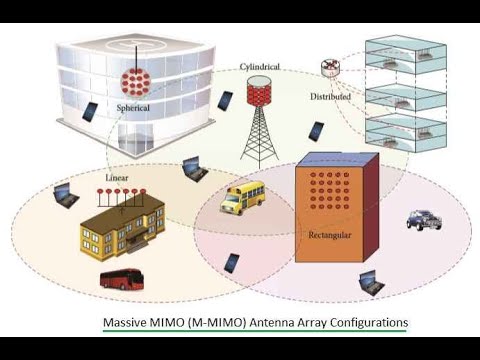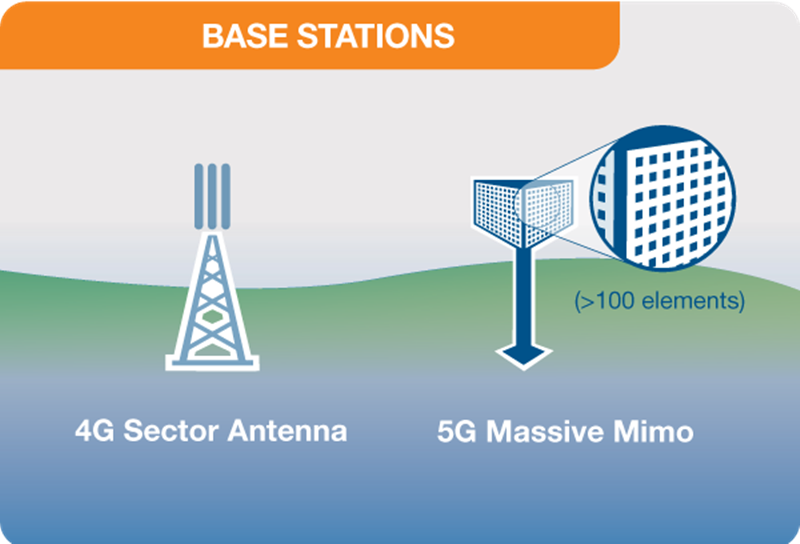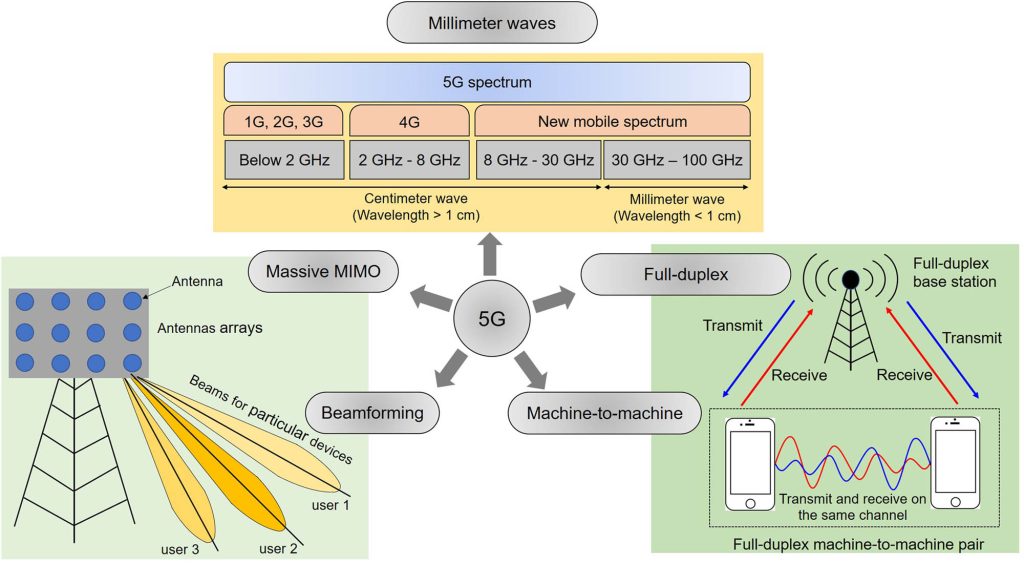The advent of faster and more efficient wireless communication systems has spawned a technological wonder that is Massive MIMO. This marvel is touted to be the cornerstone of 5G networks and beyond, promising unparalleled spectral efficiency and network performance enhancements.
Massive MIMO operates by leveraging multiple antennas at both base stations and user devices to boost capacity, coverage, and energy efficacy. The use of mammoth antenna arrays enables spatial multiplexing which allows for simultaneous transmission of data streams across several users over the same frequency band. Consequently, conventional wireless communication systems pale in comparison as far as spectral efficiency is concerned.
To further enhance this remarkable system’s capabilities, experts are currently exploring diverse techniques such as interference management, beamforming strategies or power control schemes among others. These approaches seek to minimize inter-cell interference while optimizing resource allocation in multi-cell massive MIMO architectures. Additionally, uplink and downlink transmissions present unique challenges that necessitate careful consideration during the design phase.
As research into Massive MIMO continues its meteoric rise thanks to hardware advancements coupled with software optimization tools; future areas of inquiry will revolve around developing new detection algorithms that can handle larger antenna arrays efficiently without compromising on spectral efficiencies across various applications domains like IoT (Internet of Things), autonomous vehicles or smart cities amongst others.

Understanding Spectral Efficiency in Wireless Communication Systems
Contents
- 1 Understanding Spectral Efficiency in Wireless Communication Systems
- 2 Technology for and Beyond: Improving Spectral Efficiency
- 3 Massive MIMO Technology: Achieving High Spectral Efficiency
- 4 Performance Evaluation of Massive MIMO Networks
- 5 Uplink and Downlink in Massive MIMO Systems: Challenges and Solutions
- 6 Future Research Direction for Spectral and Energy Efficiency in Massive MIMO Systems
- 7 Detection Techniques for Massive MIMO Systems: Achieving Better Spectral Efficiency
The bewildering concept of spectral efficiency is an imperative metric for wireless communication systems, including the latest 5G networks and future technologies. It pertains to the amount of information that can be transmitted over a specific bandwidth or frequency spectrum. Due to the surging demand for high-speed data transmission, cellular network operators strive towards improving spectral efficiency.
A cutting-edge technology that has emerged as a potential solution to enhance spectral efficiency is massive MIMO (Multiple-Input Multiple-Output) technology. This revolutionary technology employs multiple antennas on both ends of the system to boost capacity and minimize interference in wireless communication systems. By providing higher throughput rates with lower latency, massive MIMO can substantially improve 5G networks’ performance.
However, developing new technologies for 5G networks and beyond poses unique challenges in enhancing spectral efficiency while maintaining energy efficiency. To tackle these hurdles, researchers are delving into novel approaches such as advanced signal processing techniques, intelligent beamforming algorithms, and dynamic resource allocation schemes. These solutions aim at optimizing radio resources utilization while minimizing energy consumption in massive MIMO systems.
To summarize, elevating spectral efficiency is pivotal in optimizing wireless communication systems’ performance in current and upcoming 5G networks. Massive MIMO technology holds significant potential for accomplishing this goal by augmenting capacity and minimizing interference through multiple antennas on both ends of the system. As research progresses towards more efficient technologies for 5G networks, we anticipate further advancements towards superior spectrum efficacy with increased energy savings advantages.

Technology for and Beyond: Improving Spectral Efficiency
The enigmatic cellular network landscape is fraught with an insurmountable challenge – how to improve spectral and energy efficiency. As the number of users and devices burgeons, communication systems are in dire need of augmenting their channel capacity while minimizing energy consumption. However, fear not! This conundrum has spurred the development of innovative technologies for 5G networks, one such being massive MIMO technology.
Massive MIMO technology employs a vast array of antennas at both the base station and user device to accomplish high spectral efficiency. With hundreds or even thousands of antennas in play, massive MIMO channels can support multiple users simultaneously without any interference whatsoever. Owing to this groundbreaking mechanism, uplink and downlink performance in wireless networks are boosted while power consumption takes a nosedive.
To take spectral efficiency up another notch, researchers are delving into newfangled techniques for detecting signals in massive MIMO channels. Linear detection methods like zero-forcing (ZF) and minimum mean square error (MMSE), along with nonlinear approaches like maximum likelihood estimation (MLE), have been explored extensively. Performance evaluation studies have exhibited that these techniques can significantly ameliorate spectral efficiency in mobile communication systems.
As we advance towards 5G networks, it’s palpable that improving spectral efficiency will be imperative for satiating the burgeoning demand for data-intensive applications. Massive MIMO technology proffers a promising solution by enabling wireless networks to accommodate more users with swifter data rates while expending less power than traditional approaches ever could dream of achieving. Continued research into detection techniques and other areas will help unlock even greater improvements in spectral and energy efficacy going forward.\n
Massive MIMO Technology: Achieving High Spectral Efficiency
The potential of massive MIMO technology to augment the spectral efficiency of wireless communication systems is nothing short of remarkable. The use of a large number of antennas at both ends – transmitter and receiver – enables simultaneous transmission and reception of multiple data streams. What’s more, an increase in the number of antennas used leads to linearly proportional improvement in spectral efficiency per unit area.
But how exactly does massive MIMO achieve such high levels of performance? Well, one way is by increasing the available bandwidth for transmission through the use of mmWave frequencies that have much larger bandwidths than traditional cellular systems. This technique can lead to significant improvements in spectral efficiency. Moreover, multiuser MIMO techniques can be employed to further enhance performance by allowing multiple users to transmit simultaneously on different channels.
Another key advantage offered by massive MIMO-OFDM technology is its ability to support uplink transmissions. This not only allows for more efficient resource utilization but also enables users to transmit data at higher rates without affecting other users’ transmissions significantly. Additionally, advanced detection techniques have improved channel estimation accuracy leading to better overall system performance.
It’s evident that combining technologies such as multiuser massive MIMO with an increased number of antennas used yields substantial gains in wireless communication systems’ spectral efficiency. As we continue researching ways to improve these technologies even further, we expect next-gen wireless networks will provide high-performance levels without compromising reliability or speed – a truly exciting prospect!
Performance Evaluation of Massive MIMO Networks
The perplexing and bursty nature of performance evaluation in designing and implementing massive MIMO systems for 5G and beyond cannot be overstated. The goal is to achieve sky-high spectral and energy efficiency while still maintaining reliable communication in multi-cell environments. However, one significant challenge that needs urgent attention is the massive MIMO channel estimation, which requires accurate knowledge of the channel state information (CSI) at both ends.
To tackle this challenge head-on, detection techniques are being developed for uplink 5G massive MIMO systems. These techniques aim to reduce interference among users by exploiting spatial diversity through signal processing algorithms such as maximum likelihood (ML) and minimum mean square error (MMSE). Additionally, research on technology for 5G and beyond has birthed new antenna arrays with higher beamforming capabilities that can support more users simultaneously.
But we can’t stop here! The future research direction aims towards achieving better spectral efficiency by exploring advanced signal processing techniques such as machine learning-based approaches that can adaptively adjust system parameters based on real-time feedback from the network. Moreover, researchers are delving into ways to integrate artificial intelligence into wireless communication systems to optimize resource allocation and power consumption in 5G and 6G networks – truly mind-boggling!
Overall, it’s crucial not to underestimate the role of performance evaluation in ensuring that massive MIMO systems meet their design goals of providing gargantuan spectral efficiency gains while minimizing costs associated with hardware complexity, power consumption, deployment challenges – a daunting task indeed!
Uplink and Downlink in Massive MIMO Systems: Challenges and Solutions
The enigmatic task of implementing uplink and downlink in massive MIMO systems is fraught with challenges, particularly channel estimation. The sheer volume of antennas makes it perplexing to accurately gauge the wireless connection between transmitter and receiver. But lo and behold, recent research has uncovered a solution: pilot sequences that improve spectral efficiency while reducing overhead to achieve impressive gains.
Alas, there’s yet another obstacle – designing energy-efficient massive MIMO systems capable of managing the escalating tide of wireless data traffic. This very topic was discussed at an international conference on wireless communications where leading researchers presented novel techniques for improving energy efficiency with low power consumption. One proposed remedy involves using millimeter wave massive MIMO antenna arrays which have shown promise in achieving high spectral efficiencies while minimizing power consumption.
To enhance spectral efficiency even further, multi-user massive MIMO systems are being developed allowing multiple users to simultaneously transmit over the same frequency band. Such advanced signal processing techniques as massive MIMO linear precoding or beamforming based detection are required for uplink 5G communication.
In conclusion, despite some formidable obstacles encountered when implementing uplink and downlink in massive MIMO systems like channel estimation and energy consumption, significant headway has been made towards achievable spectral efficiencies through innovative technologies such as multi-user massive MIMO systems and millimeter wave technology. As demand for higher capacity continues to burgeon, these advances will play a pivotal role in meeting future wireless communication needs with burstiness that leaves one awestruck!
Future Research Direction for Spectral and Energy Efficiency in Massive MIMO Systems
The potential of massive MIMO systems for spectral and energy efficiency is an exciting avenue for future research. As we move beyond the 5G wireless standards, it becomes increasingly important to enhance wireless throughput and capacity. The use of a large number of antennas at both transmitter and receiver ends in massive MIMO cellular networks has already shown promising results in achieving high spectral efficiency.
However, there are still many challenges that need to be addressed before we can fully harness the power of massive MIMO technology. For example, optimizing downlink transmission poses several difficulties due to channel estimation errors, pilot contamination, and inter-cell interference. Developing efficient algorithms that mitigate these issues while maintaining high spectral efficiency will require further investigation.
Another area requiring attention is improving energy efficiency without compromising performance. This includes designing low-power hardware architectures for antennas in the massive MIMO system, exploiting spatial diversity gain and beamforming techniques unique to massive MIMO channels, as well as optimizing power allocation strategies.
Future research directions must focus on developing novel solutions capable of addressing current challenges faced by wireless cellular networks while also exploring new possibilities beyond existing standards. By doing so, we can pave the way towards a more efficient and sustainable wireless communication era filled with perplexing advancements waiting to burst onto the scene!
Detection Techniques for Massive MIMO Systems: Achieving Better Spectral Efficiency
The attainment of better spectral efficiency in massive MIMO systems is reliant on the use of detection techniques. The surging popularity of uplink massive MIMO systems, particularly with the advent of 5G millimeter-wave, has been a catalyst for this development owing to their capability to support multiple users at once. However, detecting signals from several users concurrently poses significant challenges due to noise and interference. To tackle this issue head-on, there has been an emergence of various detection techniques explicitly designed for massive MIMO systems.
One such technique that deserves mention is the MMSE detector that leverages linear processing as a means to suppress interference while simultaneously boosting signal quality. This technique can heighten multiuser massive MIMO system performance by minimizing inter-user disturbance and maximizing capacity within the entire system. Another approach involves using detectors specifically designed for large multiuser MIMO schemes capable of scaling up conventional MIMO architectures.
As cellular mimo technology continues to advance towards more complex designs featuring base stations with hundreds or thousands of antennas, developing efficient detection algorithms becomes crucial in handling these enormous antenna arrays efficiently. Consequently, advanced detection methods are necessary for accurate channel estimation and data recovery in these scenarios.
To sum it up succinctly; improving spectral efficiency in massive MIMO requires effective detection techniques tailored precisely according to specific applications like uplink/downlink communication or large-scale antenna arrays’ needs. Developing new algorithms will enable us to meet soaring demand levels for high-speed wireless communications while ensuring optimal utilization of available resources – truly mind-boggling!


